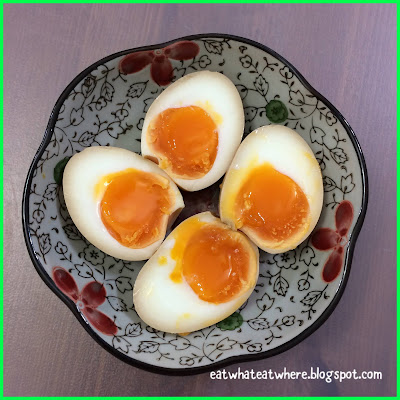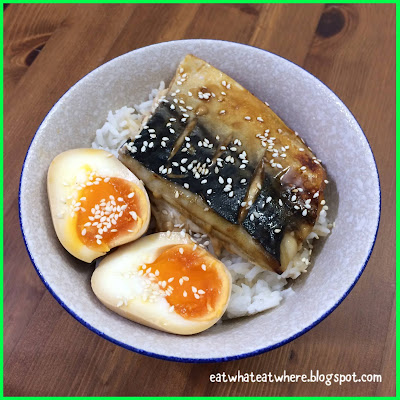A ramen egg (ajitsuke tamago or, in short, ajitama) is a marinated soft-boiled egg that is part of an important component of not only a good bowl of ramen but also makes a pretty good accompaniment in any donburi or even as a side dish eaten on its own.
To make this is pretty simple.....all you need is to nail two things. One...the cooking of the eggs to achieve a soft centred and slightly runny yolk, and two....the marinating broth.
Let's do the easy part first...the steeping marinade for the eggs. I went with the recipe from Just One Cookbook (JOC)....and made it with 2 tbsp soy sauce, 2 tbsp mirin and 3 - 6 tbsp water. I decided to go with 6 tbsp of water as I know the brand of soy sauce (Chinese soy) I have is saltier than the norm. Perhaps if you're using Japanese soy or shoyu, you can use less water. The right balance of the marinade depends on the saltiness of your soy, so give it stir and a little taste to ensure you're ok with the final flavour.
Once you're happy with the taste, pour the marinade into a ziplock bag. You can also put them in a container with a lid but you'll probably need a lot more steeping liquid than what I've used here (to ensure the eggs can be completely submerged). Just make sure you don't cram too many into the container as they'll lose their shape since the whites are pretty soft.
Now for the cooking of the eggs (I used kampung eggs). Bring water to boil in a pan (make sure the water is enough to cover the eggs). Once the water is boiling, reduce to a simmer and lower two eggs carefully into the boiling water (with a perforated ladle if necessary). I use eggs direct from the fridge as I find that simpler and easier to control since we might use different timings to get the eggs to room temperature. When I say simmer, you should still be able to see some bubbling, just not bubbling vigorously to the point where the eggs bounce around in the pan. Now, this is the hard part as the timing is crucial to achieve that sought-after runny yolk. Most recipes will tell you to use a timing of between 6 - 8 minutes. I simmered the eggs (uncovered) for exactly 7 minutes (as JOC advised).....and it worked! ^_~
Once done (when the timer beeps), take them out immediately and place them in an ice bath to stop the cooking process. When cooled, carefully peel the eggs. This turned out to be the hardest part (for me) in making these seasoned eggs coz they're just slightly firmer than soft-boiled eggs where the egg whites are lightly firm while the yolks are still slightly runny, so they're harder to handle and peel unlike hard-boiled eggs.
The first time I made these eggs, I nailed the consistency of the yolk, I think...a bit runnier than expected but still ok....but then I cracked the whites during the peeling process and had to discard them (by discard, I mean eat them up) as the steeping broth will most likely seep through the cracks...and they won't be very pretty after that. So I had to boil another two! >_< This time, I gently tap on the egg shells (with a spoon) to create more cracks so that they'd be easier to peel.
Once you've got a perfectly peeled egg with no cracks (or blemishes if you're a perfectionist like me), you're on the home stretch! Put them into your ziplock bag and tie the top with a clip or string and let the eggs steep in the liquid. This amount of marinade is good enough (I would say) for up to 3 eggs (and not 4 according to JOC). If you want to use this marinade for 3 eggs (which I tried recently), do note that you might not get perfectly browned eggs (as some parts of the egg will get squished in the bag). For best results, I would stick to 2 eggs.
Sit the eggs overnight in the fridge in the marinade. I soaked mine for 24 hours. Adam Liaw thinks that a great ajitsuke tamago is one that has been steeped for two days as he says that's when the egg yolk achieves a beautiful, more intense colour with a better taste and texture because of the longer curing process.
The moment of truth is when you cut open the egg. Phew!...the yolk was still runny. Perhaps slightly less runny than the previous one I cut open and ate immediately (without curing). I think I nailed this one better, with the edge of the yolk slightly more cooked, as the runny yolk didn't run out on to the cutting board when it was cut open. What do you think? Well, if I can get them perfect (at least to me) on my first (and second) try, I'm sure you can too.
They say if you want your egg yolk to be in the centre, you have to swirl or rotate the eggs around during the first few minutes of cooking. Well, I did do that but they don't look very much like they're in the centre. That's probably because the eggs weren't at optimum freshness judging from the larger air sac in the eggs.
Getting your perfect half-boiled ajitama egg depends on the right timing for cooking your eggs. I'd suggest you experiment the trial and error way between 6 - 8 minutes until you find your magic number. Mine was 7 minutes...but I can understand that there may be some variables in terms of the size of the egg and the amount of water used to boil the egg.
These flavourful soft-boiled eggs with that savoury-sweet balance is well-loved for its just firm egg whites and a lightly runny, custard-like yolk. If you enjoy soft-boiled eggs (like I do), you're bound to love these soy-marinated eggs.
















Ah! You finally tried it :) I love these marinated eggs but I still haven't nailed getting runny yolks every time. It is always hit and miss. The most annoying is when the egg is underdone and is a mess when peeled haiz..... That reminds me, I have yet to make deviled eggs! LOL!
ReplyDeleteHaha, deviled eggs will be so much easier to nail! ;) So I'm not alone in finding the eggs hard to peel. I'm quite surprised to hear you've not been consistent in nailing runny yolks every time coz, once you've discovered your magic number (whichever that may be for the no. of eggs you cook), it's just a matter of replicating the same cooking time and scenario...and by that I mean same no. of eggs & temperature of the eggs (aka direct from the fridge), same amount of water, even use the same pan if you have to..lol! :D The only variable I can think that may differ each time is the boiling temperature. I guess using a stove top makes it more difficult to control (and use) the same heat intensity unlike my induction cooker where I can choose to use (and stick to) a preset medium-low (90C) setting for the boiling each time. ^_~
DeleteI made Ramen eggs twice and the egg shell peeling part is the hardest part for me as I've broken a few ~>_<~
ReplyDeleteI have been thinking to make again these few days (need to get some better quality eggs) and your post appear, hehe :P
It's comforting to know that I'm not the only one who finds peeling the eggs hard to do...haha! ;D What a coincidence eh that my ramen egg post appeared as if to remind you to make your ramen eggs. ^_~
Deletewwah, perfect, I too use the 7 min trick!
ReplyDeleteAh, glad to know that we 'share' the same magic number...hehe! ;)
Delete